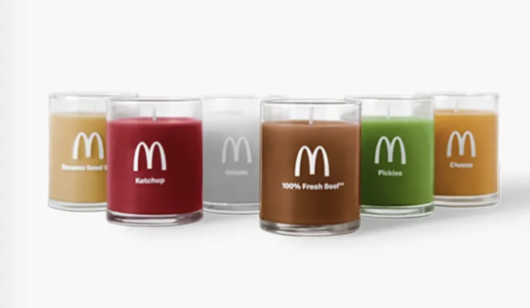‘We’re moving away from age of aesthetics’: The rise of scent marketing

Suji Sanjeevan works in scent marketing
If you’ve ever walked past a Subway restaurant, caught a whiff of that delicious bread cooking and immediately felt hungry, you’ve fallen prey to scent marketing.
Scent marketing is exactly what it sounds like: using smells to manipulate consumer behaviour. That baking you’re smelling isn’t bread at all, it is an artificial scent piped into each store in order to prompt an association each time you’re in the vicinity of a Subway.
During a future-leaning panel at SXSW (South by Southwest) Sydney on Monday afternoon named ‘From First Whiff To Fierce Loyalty’, Suji Sanjeevan explained all about the rapidly growing category of scent marketing.
Sanjeevan and her husband Jeeva both left the world of medicine to found Brand Scent, a marketing offshoot that creates bespoke olfactory branding with the aim of deepening audience connection. Scent marketing was in full effect at SXSW — that rich chocolate smell of event sponsor Tim Tam was on the air-conditioned-breeze, and I swear I could smell Chandon well before happy hour hit. Turns out, these were scents designed by Brandscent for clients, to attract attendees. Judging by the guy noisily crunching Tim Tam samples in the seat next to me, it worked a treat.
“Scent marketing is really around how you make people feel, think, and ultimately manipulate behaviour,” Sanjeevan explains.
“It really taps into one of our primal sense of smell and it’s really about creating an emotion. So when you smell something, you create an emotion, and you attach a memory. Why? Because it has a direct connection to your brain. So, you might smell something right now and in 10 years time when you’re reacquainted with that smell, it will take you right back there.
“We often say the sense of smell is the only sense that can transport you in time. That’s what we want to do with brands.”
The link between smell, taste, and memory is not a new discovery. Most famously, in the epic French novel In Search Of Lost Time by author Marcel Proust, the protagonist eats a madeleine cake dipped in tea, the olfactory sensation of which triggers a run of involuntary childhood memories.
The first edition of the book was published in 1913, and this sensation is now commonly known as the Proust Effect. The science is relatively simple: there is a direct link between one’s sense of smell and the brain’s limbic system, which regulates emotion and memory, among other things.
It first came into marketing circles in the 1970s, and was commonly used by hotel chains, looking for a welcoming and unified scent to spray in its lobbies.
“We’ve all been to bougie hotels,” Sanjeevan said. “They have a great scent. It’s about ambience creation.”
Department stores have long known the draw of the perfumed entry way. Airline lounges were also early adopters.
“But brands were really not tapping into it. Everything was very visual.”
Sanjeevan notes that, for years, successful coffee carts “didn’t realise they were doing scent marketing” as a major drawcard. As recently as five years ago, Sanjeevan says scent marketing was treated as “very much a nice to have, not a must have.”
This, she says, is changing.
“We’re moving away from age of aesthetics now into sensory marketing, emotional marketing. Brands want to stand out. Everyone’s doing digital, everyone’s doing this and that, and it’s very, very noisy. Scent marketing truly is for brands that want to stand out.”
Brand Scent works with clients in two ways. Often, it’s a one-off scented campaign that leans into the gimmicky. They just created a scented pizza dough cologne for an upcoming Domino’s campaign, and recently worked with Vegemite for their 100-year anniversary, creating an olfactory connection so powerful that Sanjeevan admitted she “didn’t want to go into the factory at that point because it was quite vile.”
She also worked with Chandon on a scent that mimicked the smell of their winery in Yarra Valley, which they use whenever they do marketing installations at everywhere from airports to SXSW conferences – the cause of the aforementioned waft of sparkling I caught on the air.
“It draws people in. So I can have the scent going here, it wafts out, and people follow their nose. In a given day, 75% of our emotion is governed by scent. Chandon uses that for activations. They also merchandise it, so they then commercialise the scent. But really, it’s about creating an emotional impact with their marketing.”
The other type of work she does is creating what she calls “olfactory logos” – a sensory brand identity.
“We’ve worked with a number of construction companies, and it’s about the consumer journey,” she explains. “From the moment they come in contact with your brand, this scent is there. For example, if you use one of our builders, the moment you walk through the display homes, the moment you go into the showrooms, at settlement, and throughout.
“And so when you’re re-exposed to that scent, you think about the experience you’ve had. So what we’re doing here is really touching base with that sensory side.”
Scent marketing has traditionally been perceived as an expensive folly, Sanjeevan explained, saying marketers baulk at the non tangible aspects of it, and the unclear return on investment. This is changing. BYD has upped the ‘new car smell’ ante with scented cartridges that clients can choose, and which pump through a vehicle’s air vents.
“We’re moving from just having it in hotels and lounge spaces, to everywhere. Every touch point is becoming extremely sensory.”
Sanjeevan says scent is coming on fast.
“Industries that you’d never associate with scent marketing, we’re working with.”
These include football clubs looking for an exclusive scent when entertaining corporate clients, and nursing homes — who use scent to alleviate pain points, surreptitiously swaying the moods of residents who may be agitated or refusing to eat. This leads to staff retention, and overall, becomes a business case, as well as a form of non-invasive treatment.
Health care and gaming are the next two major frontiers for the industry.
“How can we incorporate scents into gaming headsets? When they’re playing on the soccer field, the scent of grass or leather or something else comes out. Or if you’re doing F1 racing, you have that kind of burnt rubber smell.
“Or with tennis balls — when you pop open these tennis balls, that iconic smell you get — you might be playing tennis on the Nintendo, and you’ve got this headset on.”
The healthcare side, especially used in conjunction with wearable tech, is where the industry will move past marketing. For example, a scent for dentist rooms that alleviates anxiety.
“We’re prototyping at the moment,” Sanjeevan said. “Taking the data that we have — having worked in nursing homes and now childcare centres as well — and applying it as a wearable.
“It will be something that detects your heart rate. So, when you’re in an open space, you have anxiety or panic attacks, your heart starts racing. There are different signs. So, partnering with a Fitbit of sorts, or Samsung, and you have a device that releases a scent.
“It’s not visible. It’s not something clunky. It’s still inconspicuous, but it makes that person feel safe. They smell it. Ultimately, it relaxes them.”




Is this serious? Proust, maybe. Walking past a Subway is dreadful experience. And Quarter Pounder scented candles has to be for losers.